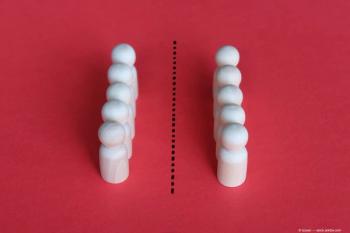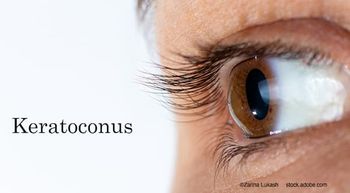
Digital marking system shows accuracy for toric IOL alignment
Though both ink marking and a newly introduced digital markerless system for toric IOL correction are effective, the digital system improved predictability and eliminated outliers in a comparison study.
Take-home message: Though both ink marking and a newly introduced digital markerless system for toric IOL correction are effective, the digital system improved predictability and eliminated outliers in a comparison study.
By Nancy Groves; Reviewed by Daniel Black, MBBS, FRANZCO
Birtinya, Queensland, Australia-A digital markerless system (Callisto, Carl Zeiss Meditec) seems to be a more accurate alignment method for toric IOLs than ink marking, which has been considered the gold standard, in a recent evaluation.
The new digital system appears to improve predictability, because it eliminates several potential sources of error, said Daniel Black, MBBS, FRANZCO. He performed a single-surgeon study comparing ink marking and the digital markerless system at his clinic in Birtinya, Queensland, Australia.
Steps where errors may occur include: obtaining correct alignment during capture keratometry, obtaining accurate measurements, transcribing calculations, correcting alignment during preoperative marking of the cardinal axis, marking the steep axis, and aligning the IOL.
“To get good results, correct alignment of the lens is mandatory, but the correct alignment of the lens doesn’t start in the operating room as you’re putting the lens in the eye,” Dr. Black said. “It starts when the patient attends the ophthalmologist’s office for biometry, and between there is a whole series of potential sources of error.
“If the patient’s head is tilted by 10° when measuring the keratometry, it could result in a 10° error,” he said. “And if the ink used in marking runs or smudges, that could add 5° of error. Without even having to look too hard you can think of 15° of potential error, all of which will interfere with a good result.”
Comparison study
Because of the critical role of accurate measurements, Dr. Black decided to study the performance of ink marking and the markerless system.
Results of the comparison demonstrated superior accuracy with the markerless system.
“Very much to our surprise, we found that we had been effective in removing the outliers and bumping our benchmark up from 94% to 99%,” Dr. Black said. “The only variation was the marking system.”
A senior lecturer at the University of Queensland, Dr. Black performed all surgeries using a single IOL (Tecnis Toric, Abbott Medical Optics). All surgeries had bimanual phaco-chop, and the IOL was implanted through a 2.2-mm incision and aligned with the marked steep axis.
Dr. Black evaluated 1-month postoperative refraction in 507 cases in which ink marking was used and 161 cases with digital marking. The first group was much larger because the system is relatively new. Digital marking was used on all patients who presented after August 2014.
The results for cylinder correction showed that mean postoperative refraction was 0.18D for ink marking and 0.17 D for digital; the SD was 0.30 and 0.24, respectively. More eyes in the digital marking group were within ≤0.5 D of target: 99.4% versus 94%. Similarly, 100% of the eyes in the digital marking group were within ≤0.75 D versus 98% in the ink-marking group. There was a significantly higher probability of being within ≤0.5 D postoperatively in the digital-marking group (p = 0.028).
Postoperatively the results for sphere correction showed a mean absolute error of 0.31 in both groups; the median error was 0.28 in the ink marking group and 0.27 in the markerless group. The standard deviation was 0.38 and 0.37, respectively.
Benefits of markerless system
While both methods are effective for toric IOL correction, the markerless system improved predictability and eliminated the outliers, Dr. Black said.
It also improved operating room efficiency, as there was no need for preoperative and intraoperative marking. Further, the system provided photographic documentation of the aligned IOL postoperatively.
Dr. Black also found that with the digital system, it was no longer necessary to mark the cardinal axis or the steep axis as separate maneuvers.
With the system, a reference image is taken when the patient presents for biometry. The data is transferred to the digital system via USB in the operating room, the axis for IOL alignment is entered, the patient image is registered under the microscope, and a digital overlay in the microscope optics is matched with what is seen when the patient is on the operating table.
The integration of the marking system into the biometry and the microscope could play a role in the comparative efficacy observed in the study, Dr. Black said.
He now uses the system on all of his toric IOL patients. Based on his experience, Dr. Black stressed that surgeons should pay close attention to detail when performing biometry with this new system or any other.
What is being measured during keratometry is not the curvature of the cornea but a reflection from the tear film, Dr. Black explained. He recommends performing keratometry on virgin corneal tear film, since dilated, anesthetized corneas will result in degraded tear film and, in turn, a degraded reflection that could corrupt measurements.
“If you’ve got corrupted or poor keratometry to start with, the best system in the world isn’t going to help you,” he said.
Dr. Black also noted that his results of the comparison study used actual postoperative astigmatism by refraction, not predicted residual astigmatism. The predicted astigmatism measurements will be available soon.
Daniel Black, MBBS, FRANZCO, FRACS A/FACAsM
This article was adapted from Dr. Black’s presentation at the 2015 meeting of the American Society of Cataract and Refractive Surgery. Dr. Black does not have any financial interest in any product or company.
Newsletter
Don’t miss out—get Ophthalmology Times updates on the latest clinical advancements and expert interviews, straight to your inbox.



















































.png)


